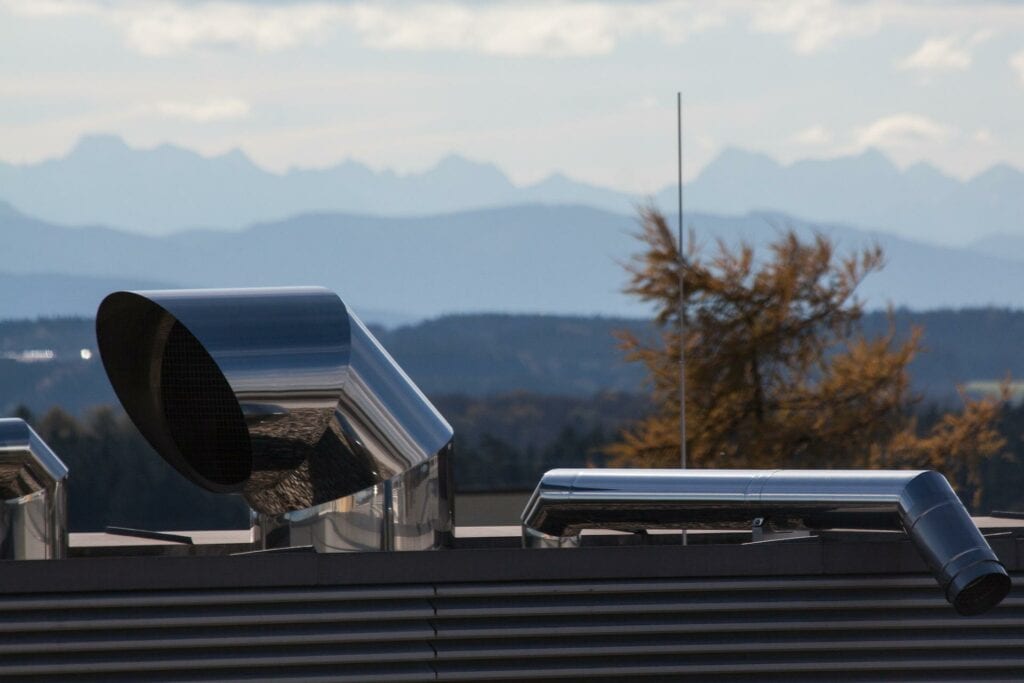Can You Vent a Dryer Through the Roof? Types, Safety & Disadvantages
-
Pete Ortiz
- Last updated:

Planning new home construction is a dream opportunity for many, but it doesn’t come without its share of difficulties. Many new home builders face the common issue of figuring out how to vent their dryer when it isn’t near an external wall. When you’ve finally landed on the perfect floor plan, this one minor problem can build into an enormous frustration.
Fortunately, if venting out of the wall is out of the question, venting up might still be a solution. In many situations, you can vent a dryer through the roof of your house. We’ll explain when you might want to take this route and discuss some of the benefits and drawbacks of this type of dryer vent installation.
 Can You Vent a Dryer Through the Roof?
Can You Vent a Dryer Through the Roof?
If you cannot reasonably run a duct through a wall or crawlspace to an exterior vent, you can run a vent through the roof. The International Residential Code, the standard for construction rules and regulations, only stipulates that the dryer vent must bring the moisture outside the house and not connect with other systems.

Disadvantages of Venting a Dryer Through the Roof
Although you can run a dryer vent through the roof, it’s rarely a good idea if you have a wall-venting alternative. If you’re stuck in the middle and wondering whether you should go through the roof or the wall, consider these drawbacks to venting a dryer through the roof:
- Potential for leaks and water damage from rain around the vent
- Cleaning lint from the vent becomes more complicated and dangerous
- Condensation could drain back down the pipe, creating a track of moisture that can develop mold and catch more lint
- Steep roof pitches require long duct runs
Venting a dryer through the roof versus the wall generally presents a greater fire risk, especially when the duct travels up multiple floors.
A roof dryer vent may also make you more hesitant to clean your duct since it’s in a hard-to-access area. According to the National Fire Protection Association, failure to clean dust, fibers, and lint from the dryer is the top cause of house fires involving laundry equipment, so having difficulty with regular maintenance could become a serious safety problem.
Find a HVAC, AC and duct specialist in your area, and get free, no-commitment estimates for your project.Consult a HEATING & COOLING expert

When Would You Need to Vent a Dryer Through the Roof?
Despite their glaring downsides, roof vents are becoming more commonplace with the growing popularity of slab foundations. Over 63% of homes built in 2019 went up on slabs. Despite their many benefits, these flat foundations take away critical venting options and make roof venting a necessity.
Dryers remove loads of moisture from wet clothes, so they have to vent outdoors. Moisture will build and eventually lead to mold, pest infestations, and foundation problems if the outlet is anywhere under or within the home.
The problem is that some homes on slab foundations have a laundry room that isn’t against an exterior wall. Unlike houses with basements and crawl spaces, you can’t run ducts under the floor of a slab home. If you don’t have an interior wall connecting to the outside where the duct can hide horizontally, you’ll have to vent through the roof.
Duct Length
To decrease the risk of lint buildup and subsequent house fires, you should always keep the duct length to a bare minimum. Although you might be able to run a duct to an exterior wall vent, roof venting may still be the best option if it offers the straightest path and shortest duct length.
If you have a steep roof pitch, you may have another option to cut the duct length further — venting through the soffit. You can run a duct into the attic and then horizontally to the roof’s edge, ending at a downward-facing vent. Venting in this position can reduce the potential for leaks and make cleaning easier.
Exterior Vent Positioning
Even if you can vent through the wall and it’s the shortest route to the outside, roof venting may still be the best option. The IRC limits the proximity of a vent to a neighboring home or entryway. For instance, if you can’t position a vent more than 3 feet away from a door in any direction, you’ll have to vent through the roof. Roof venting could be the only option in townhomes and other arrangements that tightly pack homes together.
Find a roofing specialist in your area, and get free, no-commitment estimates for your project.Consult a Roofing expert

How Far Can You Run a Dryer Vent Pipe?
According to the IRC, a dryer exhaust duct running from its connection with the transition duct (i.e., dryer-mounted flexible vent tube) to the outlet terminal or the exterior vent, can measure up to 35 feet long. The transition duct can be up to 8 feet long, so you get a total potential duct run of 43 feet. If the manufacturer’s instructions allow for a longer run, that direction supersedes the IRC’s standards.
Elbows in the dryer exhaust duct affect the maximum allowable length. Ducts have length limitations to prevent airflow restriction and dust buildup and reduce the possibility of a dryer fire. Every elbow in the duct throttles the airflow, so you have to make up for it with a shorter duct.
The IRC includes a chart showing every elbow type (angle, size, and shape) and the equivalent length to take off the 35-foot total. For example, a 4”-wide, 90-degree mitered elbow has a 5-foot equivalent length. With one elbow, you can have a 30-foot straight duct run.
How To Safely Vent Through the Roof
To safely install a roof venting system for your dryer, it’s critical to start by referencing the manufacturer’s guidelines and the IRC. Ducts need to be as short as possible and made of rigid, smooth metal at least 4” in diameter. The following are some essential tips to keep your dryer vent and duct from having issues:
- Install dryer caps to prevent water and animals from infiltrating the vent
- Do NOT install a protective screen, as it can prevent lint from flowing out of the vent
- Use a damper with at least two to three fins to block the vent when the dryer is off
Working with a professional for your dryer roof vent installation is the easiest way of gaining peace of mind. But even with the best setup, the most crucial component of preventing fires is regular maintenance.

Dryer Roof Vent Cleaning Tips
Clean your dryer vents at least once a year, but also pay attention to signs of excess buildup, so you can do an immediate cleaning before trouble arises. If it’s taking clothes longer to dry, or if you’re noticing extra humidity in the laundry room, it means moisture isn’t leaving as it should. In some instances, you may even see excess lint buildup, smell a burning aroma, or find an error code on the dryer telling you there’s a problem.
Cleaning a vertical roof vent is more challenging than an easy-to-reach horizontal wall vent, but there are simple steps you can take to make the chore as quick and easy as possible.
- Turn off the breaker for the dryer
- Remove the flexible vent tube from the wall and dryer
- Vacuum the inside of the flexible tube
- Stick a leaf blower in the wall port and blow air through the vent duct for a minute or two
- Check the roof vent to confirm lint is coming out
- Vacuum out the tube to remove the loosened dust
If you don’t have a leaf blower, you can also get on the roof and run a stiff wire down the duct to remove clogs. After loosening the stuck-on lint, vacuum the fallen debris through the wall port.
 Final Thoughts
Final Thoughts
Although it is possible to vent through a roof, this type of dryer outlet installation has several substantial weaknesses compared to venting through a wall. Over time, cleaning challenges and increased fire risks can become a time-consuming and stressful headache.
There are hundreds of details to consider in a new home. Although dryer venting is an easy aspect to miss, it can also be one of the most crucial. If you’re planning a new home, talk with your builder to see how you can vent your dryer through an outside wall and avoid the struggles and risks of an everyday household hazard.
Featured Image Credit: Volodymyr Kyrylyuk, Shutterstock
Contents

 Can You Vent a Dryer Through the Roof?
Can You Vent a Dryer Through the Roof?
